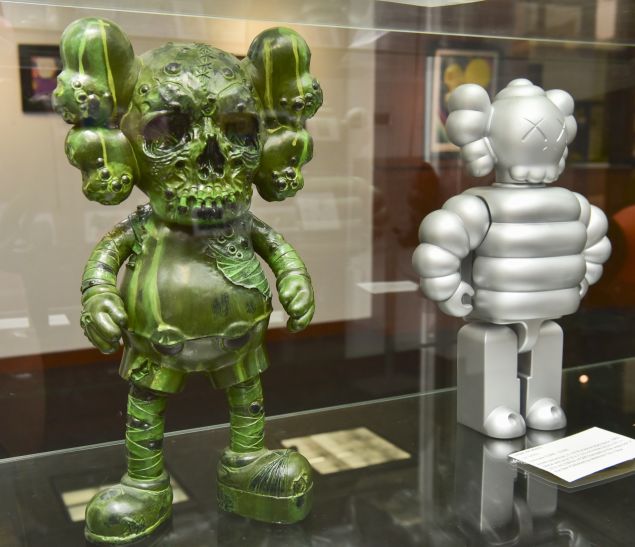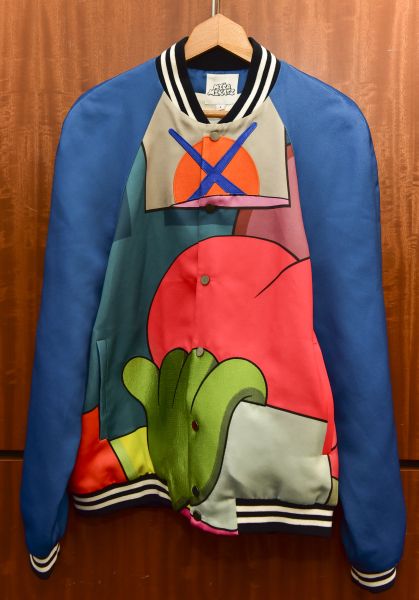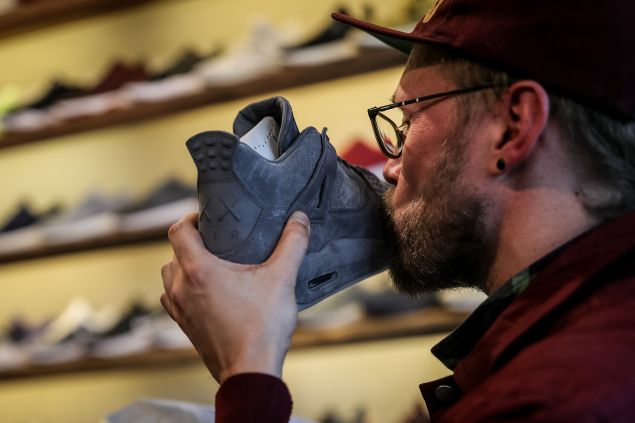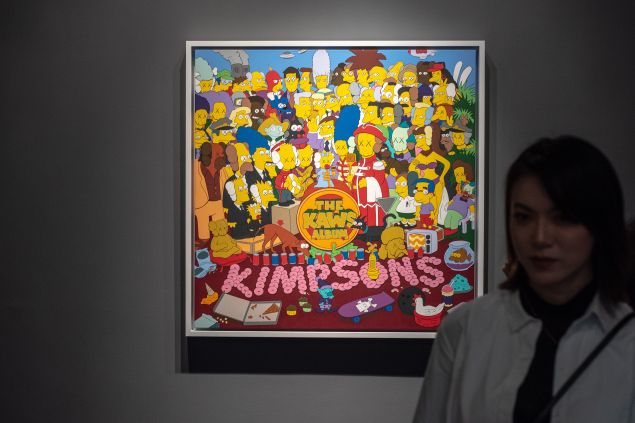
Over the phone, curator and KAWS collector Ronnie Pirovino speaks slowly and carefully, as if his enthusiasm for the artist threatens to break out at all times. Pirovino comes from a marketing background, so every once in a while the conversation also comes with a flash of used car salesman—but for one marked difference. Pirovino isn’t full of shit.
I’m speaking to the curator because he’s put together a collection of urban art for Heritage Auctions that will be sold July 22 and 23, and includes a KAWS Companion bus stop painting. Considered a marquee early work from 2001, the artist rendered an outline of a vaguely familiar cartoon character. With XX’s for eyes, Dumbo-like ears, and a pair of Mickey Mouse shorts, KAWS painted the work by filling the negative space with black acrylic. When hung against a lit ad, the piece literally glows, obscuring the whatever corporate message exists with the drunken character. (The artist refers to the series as “subvertising,” adding trademark tags such as XXs and skulls to otherwise mundane ads.)
SEE ALSO: NYC’s New Museum Is the Latest Art Institution Feeling the Pressure to Expand
KAWS, the 45-year-old New Jersey native turned New Yorker named Brian Donnelly, abandoned that message long ago, though. Now associated with mass market, middle market and high-end retailers, many describe KAWS as the first artist with global reach. He’s worked with such firms as Uniqlo, Christian Dior and Galerie Perrotin (his gallery of over a decade, from which he announced his departure last week), and with 2.2 million followers and growing on Instagram, there may be no other visual artist with as large a fan base.

Excitement around his work and impact has grown continuously. After graduating art school in 1996, he began working in the New York graffiti scene and built a cult following for himself. By 1999 he was already collaborating with toy and clothing manufacturers in Japan, billing himself more as brand than an artist by focusing on developing product, not original works or limited editions. His big streetwear breakthrough came in 2001 with his collaboration with BAPE, led by Nigo. Within the span of three more years he’d connected with the hip hop scene, which led to all kinds of other opportunities. In 2008 and 2017 he collaborated with Nike to make Air Force 1 trainers and Air Jordans respectively, and in 2016 he teamed up with Uniqlo.
His art followed suit, and so has the feverish pitch of his fans. Works that five years ago sold out after only half an hour online now go in seconds. This June, after he announced he would launch his last T-shirt edition with Uniqlo, Chinese shoppers charged the store, tearing the shirts off mannequins and brawling over the tees. In April, his painted riff on a Simpsons’ Beatles album cover shattered his previous auction records selling for $14.7 million U.S. at Sotheby’s Hong Kong. Three weeks ago, a 10-inch wood sculpture in an edition of 100 sold for a quarter million dollars. No other artist has had this level of brand and art world success in so many parts of the world.
Emotions run high in this kind of market. Within the art world, critics bitterly complain the artist is not worthy of the success, citing marketing and celebrity culture, not artists, as comparable touchstones. KAWS might not yet have the kind of vitriol attached to establishment artist and art-toy manufacturer Jeff Koons (earlier this year, a defense of Koons by New York Times art critic Roberta Smith was met with calls for her dismissal), but the social media outcry over the Brooklyn Museum’s announcement of a KAWS retrospective slated for 2021 puts him dangerously close. (Neither Brian Donnelly nor Brooklyn Museum director Anne Pasternak responded interview requests for this article.)
Within the KAWS marketplace, the emotional landscape feels fragile. I expected to recount stories from collectors of blind euphoria equivalent to puppy zoomies. What else could account for the bizarre state of the market? But the last few years of ecstatic activity around the artist added a complicated swirl of anxiety, and even sadness, to the joy so many experience with his work—a minefield many negotiated with a kind of honesty and thoughtfulness rarely seen in the art world. This community, which includes curators, writers, collectors, auctioneers and even casual observers, tell the story of KAWS.
An Art Practice Built on Branded Collaboration
Pirovino often describes the late nineties and very early aughts as unifying for KAWS collectors and fans. Members of this community paid close attention to online message boards and blogs to suss out the location, date, potential quantity and price of the works. At that time, few users were able to post images online due to technology limitations, and social media did not yet exist. A lot of leg work went into even locating works like the bus stop paintings.
RJ Rushmore, a writer who co-curates the series “Art in Ad Places,” which replaces bus stop shelter ads with art, describes the KAWS works as influential enough that his project is often viewed through that lens. “Many people say, you’re doing what KAWS did, right?” Rushmore said the message of his series is to thwart ads, but KAWS sought the legitimacy of the brand. “Early graffiti writers might put a Mickey Mouse beside their name because using a recognizable character draws attention to it. Graffiti is a marketing campaign.”

Subject matter that lends itself to popularity contributed to KAWS’ rise, said Alan Zeng, founder of the Street Art department at Paddle8. “His main aesthetic is cartoons,” he told Observer over the phone while describing the artist’s background—art school degree in illustration, and New York graffiti artist of the ‘90s. “The nostalgia of cartoons taps into most people’s childhood memories.” Martin Lerma, a fashion writer, historian and art director, reinforced this point. “There’s a really strong connection between designers that came of age at a certain time and what you’re seeing on the runway; KAWS is a great example of that,” he explained. “He’s very friendly with Kim Jones, the head mentor at Dior and who is himself very much invested in streetwear culture. If you look at them, they’re men of a similar age—mid-forties. They were seeing these clothes in the late ‘80s and early ‘90s being worn, often by people of color.”
According to Lerma, fashion appropriates these cultures while rarely including those people in the conversation, which promotes creative stagnation. While fans frequently cite KAWS as an artist with vast appeal, his critics just as often criticize him for a lack of originality and content.

Collectors don’t seem to agree or care about the opinions of critics, though, and the growing popularity of street art in the early aughts primed KAWS for success. “Personally,” said Rushmore, “I’ve always been a fan of KAWS’ transition [from] names to characters because it’s a hard transition to make.” He explained that because most graffiti artists focus on fancy lettering, transitioning to a character both breaks with established norms within the practice and requires a different kind of technical mastery not every artist has. “It’s pretty impressive that he was able to use XXs as eyes and that was his logo. It’s identifiable and now sold in Uniqlo. From the perspective of the graffiti writer, that’s the dream.”
While Rushmore described KAWS as an appropriation artist, Greg Allen, a former daddy blogger, and an active art blogger didn’t agree with the label. Speaking to the artist’s use of cartoons, Allen told me emphatically, “It’s not licensing, and it’s certainly not appropriation.” The blogger pointed to MediCom’s BearBrick dolls, a basic naked form the company would skin with designs by artists, including KAWS. “It’s just reworking somebody’s intellectual property for their benefit. You get the glow and you try to make something look edgy.”
Allen views KAWS’ work exclusively through the lens of marketing, not art, and compared KAWS dolls to McDonald’s Happy Meal toys. “The toys are a medium that they use to promote whatever media property comes along to children,” Allen began. “The whole vinyl KAWS thing was developing the medium of Toys for Adults. They’re just pointless promotional toy garbage that exists solely to be collected.”
Why do adults like KAWS? Allen describes these collectors as anti-vaxers—immune to fact—but another explanation may simply be that consumers like brands for the comfort of familiarity. The rise of artists whose use of brands to appeal to larger audiences, such as CJ Hendry Takashi Murakami, Jeff Koons and Andy Warhol, suggest as much.

While the KAWS ascension occurred organically, (according to collector Selim Varol, the artist did not even have his own domain for a long time), the artist’s business acumen separates him from figures like Warhol who hired skilled businessmen to run his studio. Zeng points out that KAWS works with only a tiny fraction of the companies who reach out to him, carefully cultivating his own brand. “Although his reach is massive, he has tight control of his own branding down to the meticulous details.” Part of this includes giving heavily to charity and promoting other artists on Instagram, a quality many collectors spoke of favorably. Plus, his personality lends itself to the kind cult figure status an enterprising businessman could easily capitalize on.
“He’s a mysterious person.” Zeng said, echoing the observations of many collectors. “He doesn’t say much, even if you talk to him in person. He doesn’t divulge personal information and he’s become a kind of urban legend. He’s like a public-facing Banksy,” he concludes, referring to the anonymous street artist known for his satirical art making and political commentary.
Has the KAWS Market Reached Its Peak?
Last week I received a Instagram DM from a collector. The message rescheduling our appointment came with a photo of a small cartoonish KAWS toy, splayed out on top of life jacket and pinned to the helm of a kayak. A boating trip was underway.
Idiosyncratic personalities are pretty much par for the course in the art world, but even taking that into account, this registered as a little unusual. I soon learned this collector travelled with his KAWS dolls, and introduced them as travel companions to strangers on his trips. Not your average stuffy collector.
Although Michel, (@collectionmontparnasse on Instagram) requested Observer refer to him by his first name, he didn’t withhold much else. Michel told me he’d grown tired of his Impressionist and Post-Impressionist master collection and sold it in 2006 when his kids introduced him to KAWS. (He has three boys, then 14, 12 and 8.) Now, he has 127 pieces in his KAWS toy art collection, not to mention prints, bronzes and even shoes. “He’s one of those artists who brings a smile to your face,” he said.
The joy Michel took in collecting KAWS practically buzzed through the phone, as he constantly steered the subject back to the art and how easily people connected with KAWS. By the time our conversation ended, the idea of traveling with dolls seemed a sweet compulsion driven by generosity and a desire to share.

The KAWS community of serious collectors and connoisseurs is tight-knit, and often seems to resemble the kind of online culture that might emerge out of a reddit channel. Collectors like Michel not only share a passion for KAWS, but a kind of quirkiness and disarming honesty related to a preference for directness.
The fans zealously believe his work distinguishes itself. “When you see production quality, KAWS is really picky,” collector Selim Varol (@toykio on Instagram) told Observer. Varol believes he has the largest KAWS collection in Europe with over 600 items in his collection. “He exchanges the prototypes five to ten times before he’s really happy with the result. There are other artists who do art toys but if you compare the quality, KAWS works stand out.”
Varol said KAWS doesn’t release poor quality toys, and if he does, he replaces them. “This ensures customer satisfaction. People are satisfied with what they buy.” Words like this are rarely uttered in the fine art world—perhaps because collectors are expected to live with less desirable qualities like a spoiled Terrence Koh chocolate costume.
Now, though, there’s a huge flipper market filled with people who don’t care about quality. “To me, a true collector collects what he loves,” Michel told me. “Now, I see people at Art Basel asking for KAWS, but they don’t ask what it is. They just want KAWS.” This didn’t seem to be an element Michel cared to think about much, and he immediately returned to speaking about the joy KAWS brought him.
The investor crowd now feverishly collecting his art comes arose out of his collaboration with the Michael Jordan brand in 2017, Zeng recounted. “That propelled him into another base, which tends to be resellers.” Now, what appears online sells out immediately, forcing long-term collectors to find the work on the secondary market—if they can afford it at all. “That is the bad part of reselling.”
KAWS’ fans can be more resourceful than the average fine art collector, though. “I had no money,” @jeeplife, a KAWS enthusiast on Instagram, told me of his early days of collecting. “I was buying mainly books, magazines and small goodies on ebay.” Now, thanks to flippers, his main problem is still money. “I’m trying to not put all of it into my collection. We have bigger plans like buying a house, and having a baby.”
@jeeplife told stories of incredible generosity—fellow collectors sending him free signed books and posters purely because they identified with his passion. Sometimes, these were mixed with people hoping to take advantage of that passion, offering signed KAWS paraphernalia but then charging exorbitant rates for it. Nearly all collectors groused about the fake KAWS market, which has grown so ubiquitous that KAWS now creates open editions. (Pirovino has cited his own sales as an answer to the ubiquity of fakes—collectors can trust his provenance.)
More traditional collectors seek out closed editions, and tend to look down on those who simply stuck to street art. Zeng believes they resist the gritty nature of it, and the lack of pedigree. Adding to the perception issue, collectors sometimes viewed the art as illegal. “This is not true,” he said. “Graffiti is illegal. But most street art is commissioned so artists have to gain permission from the property they paint.”
The passionate honesty of KAWS collectors and fans, combined with an eyes-open approach to collection, produces a refreshing forthrightness. “Some works are predestined to evolve into holy grails, 🏆 but a 1/4 mil feels like a bidding frenzy,” read a recent caption on Varol’s instagram account. The collector was referring to the sale to an anonymous bidder of a tiny 10-inch KAWS Companion piece in wood, which ran in an edition of 100, and the emoji suggests he views the sale as a trophy purchase. Over the phone, Varol speculated that the piece was an impulse buy. Rushmore posited that the piece was purchased by a “completist”—someone who feels compelled to own every piece in a series regardless of price.

But the question on every KAWS follower’s mind recently relates to the sustainability of the current market. No one I spoke to denied the stratospheric prices and only Varol attempted to make the argument that the KAWS market was sustainable. (Varol floated the idea that art markets were immune to depression because collectors sell art last—a position that ignores the actual art market depressions of the 90s and mid aughts.) Zeng was a bit more forthright, expressing doubt. “Personally I don’t think it is,” Zeng when asked about whether the market was stable. “But it’s become an outlier to the point where I don’t even understand it myself, even working in this industry. Normally there should be a ceiling for this kind demand. But currently, it’s at the very least maintaining if not selling at an exponential rate. He’s bucked every trend and gone against the grain.”
I heard this a lot from collectors too, generally in reference to an art world hesitant to embrace his talents. While the reticence is real, it may also be that KAWS has ridden more trends than he’s bucked. Concerns over the more recent work only reinforce speculation that a bubble might burst. When asked if critics who find the work overly commercial might have a point, Zeng conceded he could see their perspective, particularly in their response to the most recent work. Pirovino, who insisted one period wasn’t any better than the other, described the latest work as transitional. “The only thing that connects the Sesame Street characters [to his previous work] are the XX’s. With the paintings, there’s a sense of being enslaved or shackled to the images. The paintings you see today are not a departure, but a step away from what’s expected.”
As a less desirable commodity, transitional work often sells for less. Right now, though, everything is in demand. In a normal market, a work like the bus stop painting being sold by Heritage would attract plenty of collector attention because it marks a pivotal early moment when the artist’s work began to come into focus. In this environment, it’s more of a frenzy. His rise reflects a confluence of shifts in cultural taste, sound business practice and a passionate collector base willing to seek out work at almost any cost. How long that can last remains unknown, but it definitely makes watching how much this latest offering rakes in at Heritage worth following.
Update: An earlier version of this story credited figurines that had been made by Brandt Peters as the work of KAWS. The image has been replaced with one showing the work of KAWS.

